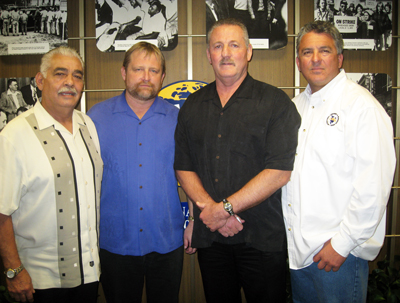The following article was published in the Winter 2010 issue of the Coast Longshore Division Newsletter.

The Coast Committee of the ILWU Coast Longshore Division: Committeeman Ray Ortiz, Jr. (Local 13), Committeeman Leal Sundet (Local 8), International President Robert McEllrath (Local 4), International Vice President for the Mainland Ray Familathe (Local 13)
If you’re a West Coast longshore worker, you probably already get information from your local union, the ILWU.org and Longshore & Shipping News web sites, and the Dispatcher. Now you can stay up-to-date on the factors that affect your jobs, directly from your elected Coast Committee at the International Headquarters in San Francisco, with the Coast Longshore Division Newsletter.
These quarterly newsletters are designed for the Coast Committee officers to communicate directly with the rank and file workers on the docks. Each issue will include articles on current affairs associated with the Industry, educational topics, and other news and information from the Coast Committee.
The Coast Committee is the elected leadership of the Coast Longshore Division. The Coast Longshore Division is made up of 30 locals, all holding charters (involving longshore, marine clerk or foreman work) with the International Longshore and Warehouse Union (ILWU).
The Coast Committee’s primary responsibility is to function as administrator of the Pacific Coast Longshore and Clerks Agreement (PCL&CA) at the Coast Labor Relations Committee step in the PCL&CA’s grievance procedure.
The Coast Committee consists of the International President (if a registered longshoreman/marine clerk), the International Mainland Vice President (if a registered longshoreman/marine clerk), and two Committeemen (one registered in California and one registered in the Northwest). The International President chairs the Committee. Most decisions are made by consensus.
Currently, the Coast Committee is made up of International President Robert McEllrath (Local 4), International Vice President Ray Familathe (Local 13), Committeeman Ray Ortiz, Jr. (Local 13), and Committeeman Leal Sundet (Local 8).
The Coast Longshore Division operates largely independently of the ILWU. It maintains separate finances and employs its own staff of nine people. It operates out of the same building as the ILWU at 1188 Franklin Street, San Francisco, CA, renting office space from the Pacific Coast Benevolent Association.
The Coast Longshore Division is just one part of the ILWU structure. Other parts include Hawaii (agriculture, tourism and longshore), Canada (longshore and towboat), Inlandboatmen’s Union (towboat, ferries, cannery and warehouse), Warehouse, Watchmen and Mining.
The ILWU prides itself as a bottom-up, democratically controlled institution. Its leadership is elected by direct vote of the members, and significant autonomy is afforded its divisions and chartered locals. To the extent that autonomy is afforded to the Coast Longshore Division, the Coast Longshore Division passes it to the locals.
The Coast Committee directly represents all activities of the Coast Longshore Division, to include PCL&CA administration, political activities and organization, inter- and intra-union politics as it relates to the interests of the Coast Longshore Division, global worker solidarity, rank and file education, and Coast Longshore Division budget and personnel administration.
The PCL&CA covers the wages, hours and working conditions for longshoremen and marine clerks employed by Pacific Maritime Association (PMA) member companies in all ports in the states of California, Oregon and Washington. Currently, that involves about 14,000 registrants and an equal number of casuals.
With respect to the Coast Committee’s role in the contract grievance machinery, it operates both in a policymaking and in an appellate role. Direct contact with rank and file members relative to contractual issues is, however, the responsibility of the locals. With the exception of Section 13 (discrimination) complaints, only the local has standing to appeal an unfavorable decision involving a registrant or casual.
Future issues will discuss the organization of the ILWU and the Coast Longshore Division in more detail.
Also of interest:
